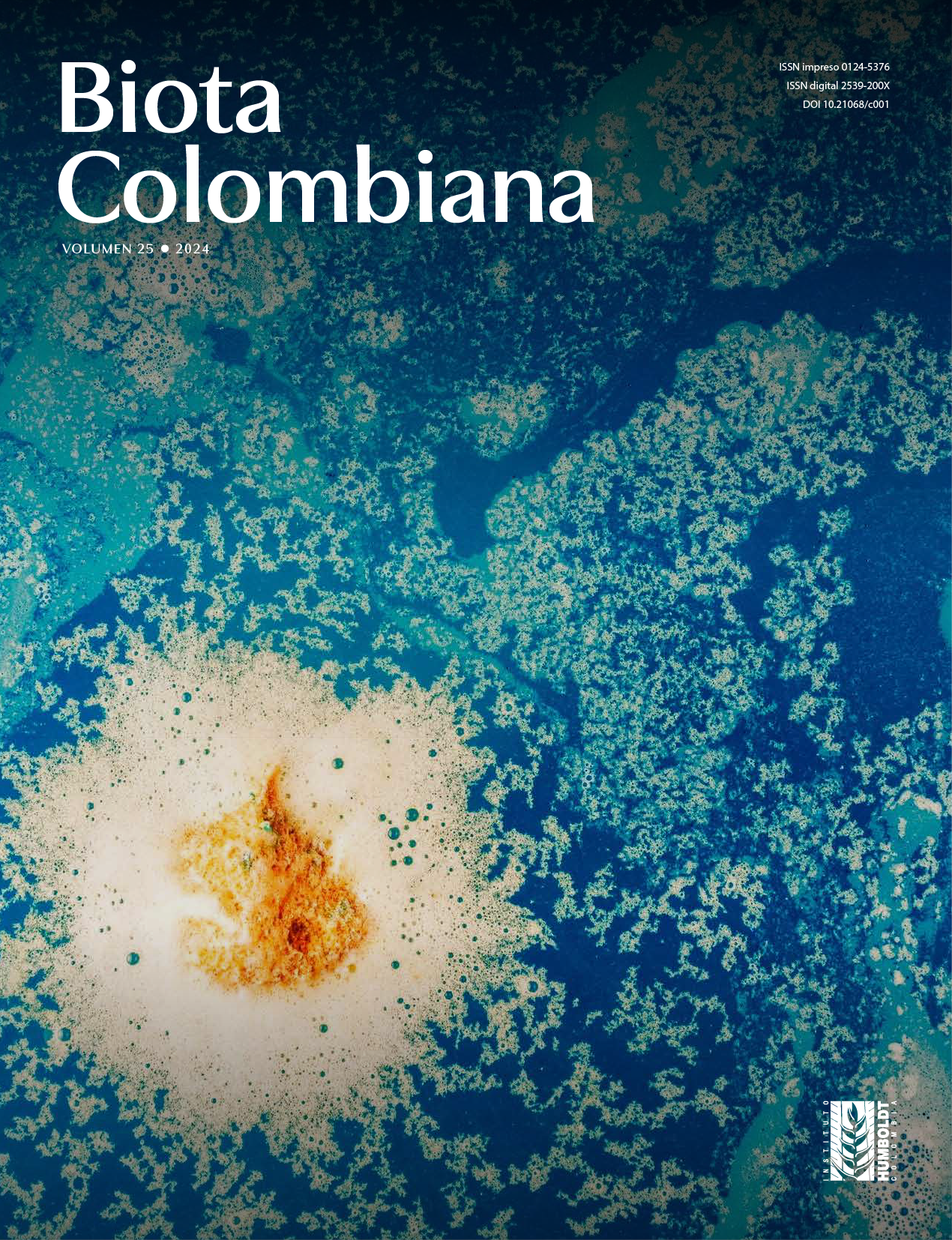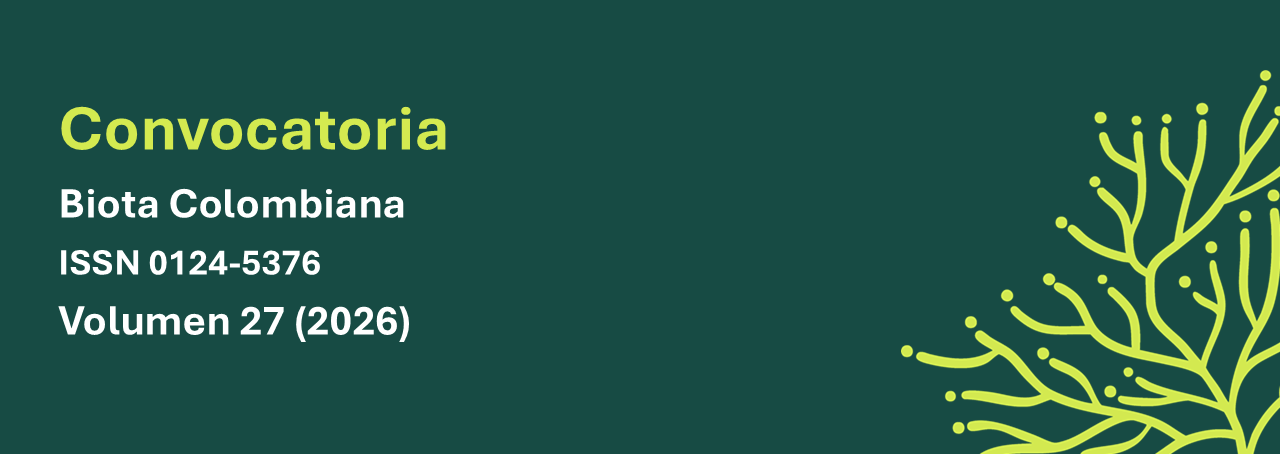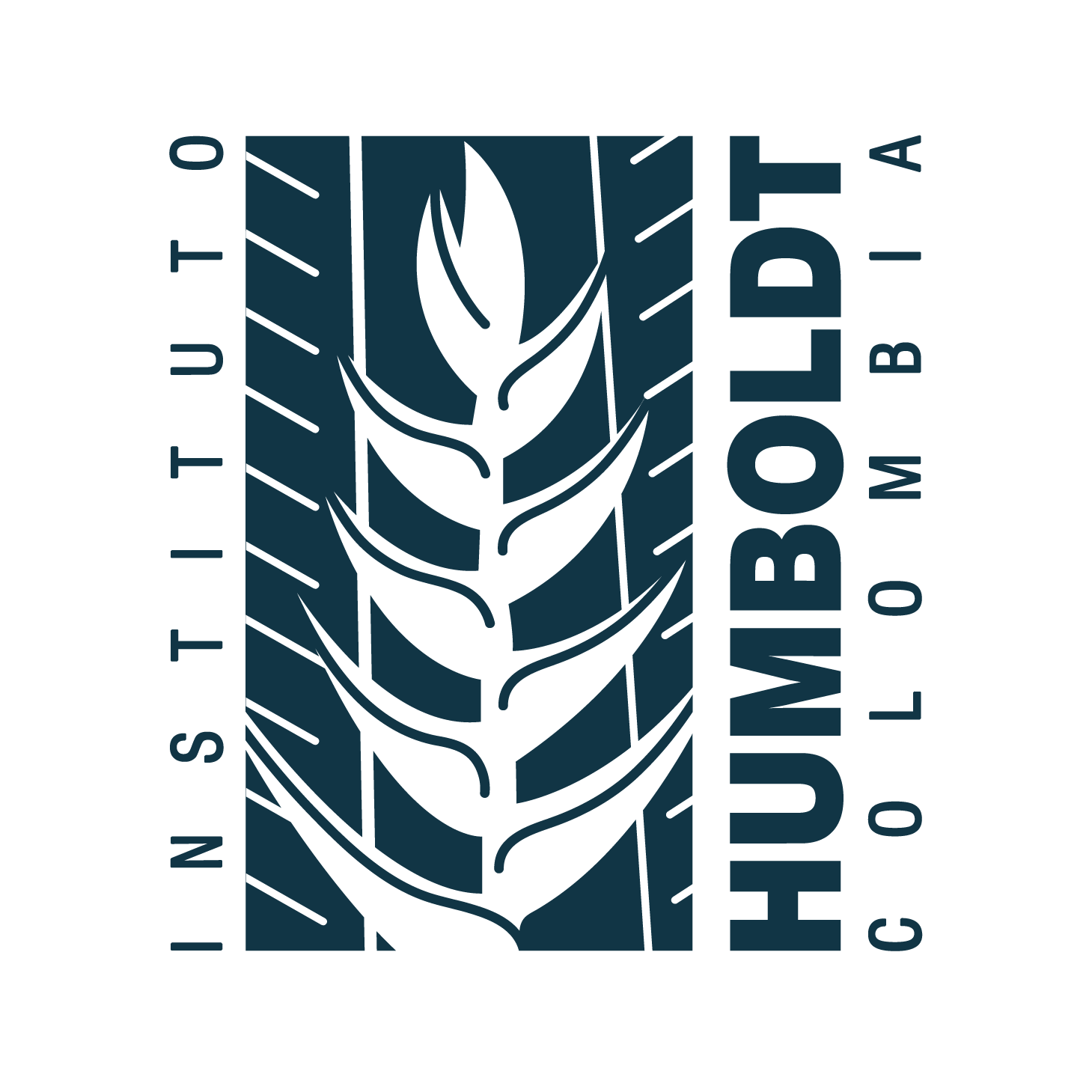Recibido: 7 de octubre de 2023; Aceptado: 7 de febrero de 2024; : 15 de julio de 2024
Resumen
Los jardines botánicos son indispensables para la conservación ex situ de flora amenazada, pero el efecto sobre su desempeño ha sido poco estudiado. En esta investigación se evaluó el crecimiento de cinco especies de Passiflora endémicas y amenazadas bajo tres tratamientos de riego en los invernaderos del Jardín Botánico de Bogotá (ex situ) y sus hábitats naturales (in situ) con el fin de generar recomendaciones de manejo y conservación. Se compararon las condiciones ambientales ex situ e in situ, el crecimiento de las especies bajo estas condiciones y los tratamientos de riego implementados mediante un análisis de varianza. Las condiciones ambientales ex situ e in situ fueron distintas, pero el crecimiento de las especies fue similar entre ellas, aunque más variable en las condiciones in situ. El crecimiento ex situ de las especies fue similar entre los tratamientos de riego, pero más alto con un riego poco frecuente. Cada especie tuvo un crecimiento particular con un patrón de compensación entre el crecimiento del tallo y el desarrollo de nuevos brotes. Las acciones de manejo en el Jardín Botánico parecen ser adecuadas para la conservación ex situ de estas especies, pero es necesario realizar un monitoreo continuo y evaluar nuevas variables potencialmente sensibles para complementar estos resultados.
Palabras clave:
crecimiento, flora amenazada, invernadero, jardín botánico, Passifloraceae, riego.Abstract
Botanical gardens are essential for the ex-situ conservation of threatened flora, but the effect on their performance has not been sufficiently studied. The growth of five endemic and threatened Passiflora species was evaluated under three irrigation treatments in the greenhouses of the Botanical Garden of Bogotá (ex-situ) and their natural habitats (in-situ), to review management and conservation recommendations. The ex-situ and in-situ environmental conditions, the growth of the species under these conditions, and the irrigation treatments implemented were compared using an analysis of variance. The ex-situ and in-situ environmental conditions were different, but the growth of the species was similar, although more variable in the in-situ conditions. The ex-situ growth of species was similar between irrigation treatments, but higher with less frequent irrigation. Each species had a particular growth with a compensation pattern between stem growth and the development of new shoots. The management actions in the Botanical Garden seem to be adequate for the ex-situ conservation of these species, but continuous monitoring and evaluation of new potentially sensitive variables remains necessary to complement these results.
Keywords:
botanical garden, greenhouse, irrigation, Passifloraceae, growth, threatened flora.Introducción
La conservación ex situ es una estrategia que complementa la conservación in situ y busca garantizar la preservación de la diversidad de especies fuera de su hábitat natural (Sharrock, 2012). Dentro de las distintas formas de conservación ex situ, los jardines botánicos desempeñan un rol muy importante en la investigación científica y el fomento del conocimiento de sus colecciones vivas, en las que se incluye un número importante de especies amenazadas (Chen & Wei-Bang, 2018; Mounce et al., 2017; Perez et al., 2018; Sharrock, 2012). Sin embargo, se han identificado varias restricciones que limitan la capacidad de conservación de los jardines botánicos, tales como la disminución del desempeño de las plantas y la adaptación a las condiciones ex situ, que reducen su potencial para habitar ambientes naturales nuevamente (Ensslin et al., 2015; Nagel et al., 2019; Volis, 2017).
Al respecto, se ha evidenciado que el tiempo de cultivo dentro de una colección ex situ genera reducción de la variabilidad genética (Ying-Chun et al., 2015; Xiao et al., 2021) y, como consecuencia, reducción de su capacidad reproductiva (Enßlin et al., 2011). Además, se ha demostrado que la adaptación de las especies dentro o fuera de su hábitat natural depende de su tamaño poblacional, el cual define su capacidad para resistir cambios (Leimu & Fischer, 2008). No obstante, sigue siendo limitada la información acerca de los efectos de la conservación ex situ sobre el desempeño de las plantas (Volis, 2017) y su rol en el entendimiento y formulación de mejores prácticas de conservación que garanticen el éxito en el mantenimiento de la diversidad de especies bajo estas condiciones.
Colombia es el país con mayor diversidad de especies del género Passiflora y la región andina alberga un gran número de estas especies endémicas y amenazadas (Bernal et al., 2015; Ocampo et al., 2007; Ocampo et al., 2017). Además, el consumo de sus frutos y su comercialización local es una de las actividades tradicionales con potencial económico en varias regiones de este país (Ocampo et al., 2007). Esto hace que su conservación sea un objetivo primordial debido a su valor ecológico, genético y cultural, lo cual puede contribuir a futuro a la seguridad alimentaria a través del mejoramiento genético de especies cultivadas (Dhawan et al., 2004; Yockteng et al., 2011; Ocampo & Coppens d’Eeckenbrugge, 2017).
Teniendo en cuenta la importancia de las especies de Passiflora, el Jardín Botánico de Bogotá (JBB) incluyó a la familia Passifloraceae dentro de las colecciones especializadas para la conservación (CEPAC) como parte de su estrategia de conservación ex situ. Actualmente, la mayor parte de la colección dentro de esta familia botánica la componen especies del género Passiflora, con 166 individuos y 36 especies, que se actualizan constantemente a través del plan de enriquecimiento de la colección CEPAC.
En 2018 se realizó la colecta y propagación asexual de cinco especies de Passiflora endémicas y amenazadas de los Andes colombianos con el fin de contribuir a su conservación ex situ dentro del JBB (Caleño-Ruíz & Morales-Liscano, 2019). De acuerdo con las categorías de la Unión Internacional para la Conservación de la Naturaleza (UICN), tres de estas especies se encuentran en estado vulnerable (Passiflora dawei, Passiflora erythrophylla, y Passiflora pennellii) y dos en preocupación menor y registradas como endémicas de Colombia (Passiflora longipes y Passiflora smithii) (Bernal et al., 2015; Ocampo et al., 2007). Desde entonces, se realiza un seguimiento a su desempeño con el fin de evaluar los efectos de la conservación ex situ, pero a la fecha no existe una directriz científica sobre cómo realizar el ejercicio de conservación para estas especies y cómo llevar a cabo actividades de mantenimiento y manejo que promuevan su éxito. Sumado a esto, la información disponible se enfoca principalmente en aspectos de cultivo y en las especies comúnmente comercializadas (Ulmer & MacDougal, 2004; Yockteng et al., 2011).
Entre los factores a considerar para el manejo ex situ, la disponibilidad de agua en el suelo es uno de los más importantes para asegurar el desempeño adecuado de especies vegetales. El déficit de agua puede limitar el crecimiento vegetativo de las plantas, así como los atributos de rendimiento de un cultivo, debido a los efectos que tiene sobre ciertas características de las flores y los frutos (Menzel et al., 1986; Fischer et al., 2009; Rao et al., 2013; Souza et al., 2018). Sin embargo, se desconoce si las variaciones en la disponibilidad de agua producen los mismos efectos sobre especies silvestres y si afectan su crecimiento y desempeño en condiciones ex situ donde, en algunos casos, el abastecimiento de agua es artificial a través del riego.
Las condiciones ambientales también son relevantes para el desempeño de las plantas cuando se establecen colecciones ex situ con fines de conservación. En el caso del JBB, la infraestructura de los invernaderos crea condiciones ambientales estándar para las especies procedentes tanto de clima frío como de clima cálido, las cuales pueden ser diferentes a las condiciones ambientales de su hábitat natural. Esto podría tener un efecto negativo en su crecimiento, tal como ha sido discutido en otros análisis (Ensslin et al., 2015; Leimu & Fischer, 2008). No obstante, son escasos los estudios que evalúan el efecto de las condiciones ambientales sobre el desempeño de plantas dentro de una colección ex situ para orientar buenas prácticas de conservación.
Teniendo en cuenta lo anterior, el objetivo de esta investigación es evaluar el crecimiento en condiciones ex situ de cinco especies de Passiflora endémicas y amenazadas bajo tres frecuencias de riego distintas, y compararlo con el crecimiento de individuos de las mismas especies en su hábitat natural (condiciones in situ), con el fin de generar recomendaciones para su manejo y conservación en el Jardín Botánico José Celestino Mutis. Específicamente, se pretende: 1) identificar las variaciones de las condiciones ambientales ex situ del JBB en comparación con el hábitat natural (condiciones in situ) y su incidencia en el desarrollo de las especies y 2) evaluar el crecimiento de las plantas entre las diferentes frecuencias de riego y especies evaluadas para identificar señales de éxito o limitaciones en su manejo ex situ.
Materiales y métodos
Área de estudio y especies evaluadas
Esta investigación se llevó a cabo en el departamento de Cundinamarca (Colombia) en cuatro localidades diferentes: los viveros de clima frío y cálido del JBB, y los municipios de Zipacón, San Francisco y Fosca (Tabla 1). Las condiciones ex situ se evaluaron en el vivero de clima frío (Banco plantular) y el de clima cálido (Nave 3) del JBB, ambos localizados en Bogotá a 2600 m de elevación. El vivero de clima frío (Banco plantular) consistió en una estructura plástica de 4 m de altura, 4,5 m de ancho y 13 m de profundidad constantemente ventilada, donde se ubicaron las plántulas dentro de bolsas plásticas negras de 10 x 30 cm al interior de canastillas que se dispusieron en el suelo. El vivero de clima cálido (Nave 3) consistió en una estructura de concreto y vidrio de 3 m de altura, 6,5 m de ancho y 8 m de profundidad, donde se ubicaron las plántulas dentro de bolsas plásticas negras de 10 x 30 cm al interior de canastillas que se dispusieron sobre mesas de 1 m de alto. Para esta condición (ex situ), se emplearon 75 plántulas de las especies P. erythrophylla, P. longipes, P. dawei, P. smithii y P. pennellii, las cuales fueron obtenidas mediante propagación asexual en el JBB (Caleño-Ruíz & Morales-Liscano, 2019); a la fecha de inicio de la investigación, tenían trece meses de edad. Quince plántulas de cada especie fueron ubicadas en el invernadero correspondiente según el tipo de clima de su hábitat natural (Tabla 1).
Notas. T1: riego una vez por semana; T2: riego dos veces por semana; T3: riego tres veces por semana; T4: testigo.
Tabla 1: Características de las localidades evaluadas, descripción de los individuos y tratamientos empleados por cada especie de Passiflora.
Condición
Lugar
Tipo de clima
Elevación (m s. n. m.)
Especie
N.° de individuos
Tratamientos
Ex situ
JBB: Banco plantular
Frío
P. erythrophylla
15
P. longipes
15
JBB: Nave 3
Cálido
2650
P. dawei
15
T1, T2 y T3
P. smithii
15
P. pennellii
15
In situ
Zipacón
Frío
2380
P. erythrophylla
3
2506
P. longipes
2
San Francisco
Cálido
1618
P. dawei
2
T4
1558
P. smithii
2
Fosca
Cálido
1346
P. pennellii
6
Para las condiciones in situ se realizaron muestreos en zonas de hábitat natural de cada una de las especies en los municipios de Zipacón, Fosca y San Francisco, entre los 1600 y 2500 m de elevación (Tabla 1). La población natural de P. erythrophylla fue de cinco individuos (dos adultos y tres juveniles) con un tamaño promedio de 1,8 m de largo; la de P. longipes, de seis individuos (cuatro adultos y dos juveniles) con un tamaño promedio de 2 m de largo; la de P. dawei, de cinco individuos (tres adultos y dos juveniles) con un tamaño promedio de 3,5 m; la de P. smithii, de seis individuos (cuatro adultos y dos juveniles) con un tamaño promedio de 2,2 m; y la de P. pennellii, de once individuos (cuatro adultos y siete juveniles) con un tamaño promedio de 1,5 m. Durante los muestreos, se marcaron e incluyeron los individuos juveniles de estas mismas especies que tuvieran un tamaño similar a las plántulas que se encontraban en el JBB para que su comparación fuera bajo condiciones ontogenéticas similares. Sin embargo, debido a que la abundancia natural de las especies fue baja, el número de individuos registrados en las condiciones in situ fue menor al de las condiciones ex situ (Tabla 1).
Condiciones ambientales ex situ e in situ
Para evaluar las condiciones ambientales ex situ, se registró la humedad y temperatura en los viveros Banco plantular y Nave 3 con ayuda de un data logger EBCHQ 94150. Se registró información mensual entre marzo y octubre de 2019 con una frecuencia de 30 minutos durante cinco días por cada vivero. A partir de estos registros, se obtuvo un valor promedio mensual con el cual se realizaron las comparaciones.
Para las condiciones in situ, se empleó información disponible del Sistema de Información Climatológica e Hidrológica de la Corporación Autónoma Regional de Cundinamarca (CAR, 2018) de las estaciones El Acomodo (código 2306516, ubicada a 1150 m s. n. m. en el municipio La Vega) y Tisquesusa (código 2120631, ubicada a 2570 m s. n. m. en el municipio de Facatativá), con el fin de calcular los promedios de temperatura, humedad relativa y precipitación de los municipios de San Francisco y Zipacón, respectivamente. Además, se empleó la estación automática Quetame (código 0010016, ubicada a 1644 m s. n. m., municipio Quetame) de la Plataforma Agroclimática Cafetera (Cenicafé, 2019) para obtener los promedios de temperatura, humedad relativa y precipitación para el municipio de Fosca.
Diseño experimental y variables evaluadas
Para las condiciones ex situ, se definieron tres tratamientos con diferente frecuencia de riego manual: una vez por semana, todos los lunes (T1); dos veces por semana, los lunes y viernes (T2); y tres veces por semana, los lunes, miércoles y viernes (T3). Por cada aplicación se emplearon 250 ml de agua potable para cada individuo. Por cada tratamiento se evaluaron cinco individuos de cada una de las cinco especies en un arreglo de dos factores (frecuencia de riego y especie) en el que se midieron en total 75 individuos (Tabla 1). Cada individuo fue sembrado en bolsas de 10 x 30 cm y como sustrato se empleó tierra negra (66,7 %) y cascarilla de arroz (33,3 %).
Para las condiciones in situ, se realizó la búsqueda de individuos juveniles de las cinco especies evaluadas en las localidades donde han sido registradas. Se marcaron entre dos a seis individuos por cada especie para un total de quince individuos en condiciones in situ que fueron considerados como el testigo (T4) (Tabla 1).
Las variables evaluadas fueron la longitud del tallo (cm), el número de hojas y brotes, la mortalidad y el número de botones florales, flores y/o frutos en cada uno de los individuos evaluados. Las mediciones de las variables fueron realizadas cada dos meses, desde marzo a octubre de 2019 (Caleño-Ruiz & Morales-Liscano, 2021). Con base en esta información, se obtuvo el crecimiento neto del tallo (cm) y cambio neto de hojas y brotes a partir de la diferencia entre el registro final y el registro inicial durante el periodo evaluado. De esta manera, los valores positivos indicaron un incremento en las variables, y los valores negativos, una disminución causada por la caída de hojas, la fractura de tallos o la mortalidad del individuo. No se incluyeron registros de estructuras reproductivas, ya que durante el periodo de muestreo estas no fueron observadas en ninguna de las condiciones evaluadas.
Análisis estadístico
Se realizó un análisis de varianza de una vía y una prueba post hoc de Tukey HSD del paquete “agricolae” (de Mendiburu, 2019) para comparar la temperatura y humedad relativa de cada uno de los lugares evaluados en condiciones ex situ e in situ. Posteriormente, se emplearon dos pruebas no paramétricas de dos vías, Scheirer-Ray-Hare y post hoc de Dunn, para comparar las variables de crecimiento entre los tratamientos y las especies empleando los paquetes estadísticos “rcompanion” (Mangiafico, 2019) y “FSA” (Ogle et al., 2019). Para la prueba de Scheirer-Ray-Hare se empleó la suma de cuadrados de tipo II para muestras desbalanceadas y se ajustaron los p-valores para comparaciones múltiples cuando se usó la prueba post hoc de Dunn (Mangiafico, 2019). Todos los análisis fueron realizados en el software R versión 3.6.1 (R Core Team, 2019).
Resultados
Condiciones ambientales en el JBB y en hábitats naturales de las especies de Passiflora
La temperatura media mensual varió entre los sitios evaluados en condiciones ex situ e in situ (F (4,39) = 156,05; p = < 0,001) y la humedad relativa tuvo una variación marginal (F (4,39) = 2,82; p = 0,038) (Figura 1). En el sitio de clima frío bajo condiciones ex situ (Banco plantular: 15,10 °C), la temperatura fue más alta que bajo las condiciones in situ del municipio Zipacón (13,27 °C) (Figura 1A), en donde habitan naturalmente las especies P. erythrophylla y P. longipes. Sin embargo, la humedad relativa promedio fue estadísticamente similar entre ambas (Zipacón: 79,4 % y Banco plantular: 78,7 %) (Figura 1B).
Para el sitio de clima cálido en condiciones ex situ (Nave 3: 17,4 °C), la temperatura fue similar a las condiciones in situ del municipio de Fosca (17,88 °C), en donde habita naturalmente la especie P. pennellii, y menor a las del municipio de San Francisco (21,89 °C), en donde habitan naturalmente P. dawei y P. smithii (Figura 1A). Aunque no hubo diferencias significativas, la humedad relativa promedio de Nave 3 (77,6 %) fue menor a la de San Francisco (78,5 %) y la de Fosca (82,5 %) (Figura 1B). Esto indica que, aunque la humedad relativa es similar entre las condiciones ex situ e in situ, la temperatura de los invernaderos dentro del JBB tiende a diferir de las condiciones naturales de donde provienen algunas especies de Passiflora.
Por otra parte, para los sitios en condiciones in situ, la precipitación media mensual fue de 163,25 mm en San Francisco, 97,13 mm en Fosca y 57,92 mm en Zipacón. En cuanto a las condiciones ex situ, al considerar la unidad de medida de la precipitación (mm o litros/m2), el área de las bolsas de siembra (0,00785 m2), la cantidad de agua (0,25 litros) y la frecuencia empleada en el riego de cada bolsa (una, dos o tres veces por semana), se aplicaron 127,39 mm/mes en el T1, 254,78 mm/mes en el T2 y 382,16 mm/mes en el T3. Estos valores indican que en la mayoría de los tratamientos de riego empleados en las condiciones ex situ, el agua aplicada fue similar o superior a la precipitación media mensual que ocurrió en los hábitats naturales de las especies de Passiflora.
Figura 1.: Temperatura (A) y humedad relativa (B) para los invernaderos en condiciones ex situ dentro del Jardín Botánico de Bogotá (JBB, color naranja) y los sitios muestreados en condiciones in situ (color verde)
Crecimiento de las especies de Passiflora bajo los tratamientos evaluados
El crecimiento del tallo y el cambio neto de brotes fue similar entre las condiciones in situ y ex situ, pero en las condiciones in situ hubo una pérdida significativa de hojas por individuo (Tabla 2, Figura 2). En general, el crecimiento de las especies en las condiciones in situ tuvo una mayor variación en comparación con aquel en las condiciones ex situ (Figura 2), en las que el manejo de las plantas fomentó un crecimiento homogéneo. Así mismo, los valores promedio del crecimiento del tallo y el cambio neto de hojas fueron menores -y en algunos casos negativos- en el hábitat natural de las especies (in situ) que en el JBB (ex situ) (Figura 2A y Figura 2B), mientras que los valores promedio del cambio neto de brotes fueron mayores en el hábitat natural (in situ) en comparación con el JBB (ex situ) (Figura 2C). Esto significa que, en promedio, el crecimiento de las especies es similar entre condiciones ex situ e in situ, pero para estas últimas hay una mayor incertidumbre debido a su alta variabilidad y mayor pérdida de hojas en comparación con las condiciones ex situ, lo cual pudo fomentar el desarrollo de nuevos brotes.
Notas. Los tratamientos corresponden al riego implementado en las condiciones ex situ del Jardín Botánico de Bogotá (T1, T2 y T3) y a las condiciones in situ consideradas como testigo (T4).
Tabla 2: Comparación de las variables de crecimiento evaluadas en las plantas entre los tratamientos y las especies.
Variables
Grados de libertad
Suma de cuadrados
H
p-valor
Crecimiento neto del tallo (cm)
Tratamiento
3
3268,1
47,89
0,188
Especie
4
17 070,1
250,12
< 0,001
Tratamiento: especie
12
13 055,0
191,29
0,085
Residuales
70
27 347,3
Cambio neto de hojas (No.)
Tratamiento
3
17 130
251,74
<0,001
Especie
4
2990
43,95
0,355
Tratamiento: especie
12
7060
103,75
0,583
Residuales
70
33 380
Cambio neto de brotes (No.)
Tratamiento
3
3230
5,02
0,170
Especie
4
11 810
18,36
0,001
Tratamiento: especie
12
8415
13,08
0,363
Residuales
70
33 784
Por otra parte, todas las variables de crecimiento evaluadas en las especies de Passiflora fueron similares entre los distintos tratamientos de riego aplicados en las condiciones ex situ del JBB (Tabla 2, Figura 2), lo cual indica que las plantas pueden ser regadas una, dos o tres veces por semana sin impactar su crecimiento. Sin embargo, aunque no hubo una diferencia significativa, los valores promedio para el crecimiento neto del tallo y cambio neto de hojas y brotes fue más alto para el T1 (riego una vez por semana) (Figura 2).
Figura 2.: Crecimiento neto del tallo (A), cambio neto de hojas (B) y cambio neto de brotes (C) en los tratamientos evaluados
Respecto a las especies de Passiflora evaluadas, se obtuvieron diferencias significativas para el crecimiento neto del tallo y el número de brotes, las cuales no fueron afectadas por los tratamientos, ya que la interacción entre tratamientos y especies no fue significativa (Tabla 2, Figura 2). Esto significa que las diferencias presentadas en estas variables entre las especies fueron una manifestación de las características propias de cada una, independiente de las condiciones de conservación y de los tratamientos de riego aplicados en condiciones ex situ.
En el caso del crecimiento del tallo (Tabla 2, Figura 3A), las especies P. dawei, P. erythrophylla y P. pennellii tuvieron las medias y medianas más altas en comparación con P. longipes y P. smithii. Además, aunque no hubo diferencias significativas, en la Figura 3B se observa que el patrón de cambio neto de hojas fue similar para las especies y estuvo correlacionado con el crecimiento neto del tallo (rS = 0,49; p < 0,001). Esto indica que durante el periodo evaluado P. dawei, P. erythrophylla y P. pennellii manifestaron un crecimiento longitudinal más acelerado que las otras especies, favorecido por una mayor producción de hojas.
En cuanto al número de brotes, el patrón de cambio neto entre las especies fue generalmente opuesto al crecimiento del tallo (Figura 3C). P. dawei y P. pennellii produjeron menos brotes (Figura 3C) y estuvieron dentro de las especies con mayor crecimiento neto del tallo (Figura 3A). Por el contrario, P. longipes y P. smithii tuvieron una mayor producción promedio de brotes (Figura 3C) y un menor crecimiento neto del tallo (Figura 3A). En el caso de P. erythrophylla, tanto el crecimiento neto del tallo como el cambio neto de brotes estuvo dentro de los valores promedio más altos (Figura 3A, Figura 3B). Esto indica que mientras para P. dawei y P. pennellii el crecimiento longitudinal fue prioritario durante el periodo evaluado, para P. longipes y P. smithii fue prioritario desarrollar más rebrotes para extender su crecimiento de forma horizontal.
Figura 3.: Crecimiento neto del tallo (A), cambio neto de hojas (B) y cambio neto de brotes (C) para cada especie de Passiflora evaluada
Discusión
En esta investigación se evaluaron las condiciones ambientales y el crecimiento de cinco especies endémicas y amenazadas del género Passiflora dentro de las colecciones del JBB y en sus hábitats naturales, con el propósito de identificar acciones de manejo que propendan al éxito de su conservación ex situ. Los resultados indican que las condiciones ambientales difieren entre los hábitats del JBB y los naturales, especialmente en cuanto a la temperatura, pero el crecimiento de las especies de Passiflora fue generalmente similar entre ambos, aunque con una mayor variación en los hábitats naturales. Tampoco se encontraron diferencias de crecimiento entre los distintos tratamientos de riego implementados en condiciones ex situ y, a nivel de especie, el crecimiento tuvo un patrón particular en el que algunas especies priorizaron el crecimiento longitudinal de los tallos existentes, mientras que otras priorizaron un mayor desarrollo de brotes nuevos.
En condiciones ex situ, la temperatura y humedad relativa fueron generalmente más altas para las especies de clima frío y más bajas para las especies de clima cálido que las reportadas para las condiciones in situ. Esto podría indicar que las condiciones ambientales que se manejan actualmente en los invernaderos del JBB no serían ideales para el desarrollo de las especies de Passiflora debido a las diferencias con su hábitat natural, pues se ha demostrado que los cambios en la temperatura impactan la sobrevivencia (Thomas et al., 2022) y afectan el desarrollo óptimo de tejidos vegetales, así como los cambios de la humedad ambiental modifican el tamaño de las flores (Carr, 2013; Fischer et al., 2009; Fischer & Miranda, 2021; Menzel et al., 1986). Sin embargo, durante el tiempo evaluado solo se evidenciaron cambios vegetativos importantes en el número de hojas entre las condiciones evaluadas, y no se observaron estructuras reproductivas que permitieran evidenciar dichos efectos. Esto sugiere que, aunque las diferencias en las condiciones ambientales entre ambos lugares son un llamado de atención importante para la mejora de la estrategia de manejo y conservación en el JBB, es necesario un monitoreo continuo de estas especies para identificar efectos a largo plazo en estructuras vegetativas y reproductivas.
Este monitoreo es especialmente importante, pues existe evidencia que señala que las diferencias ambientales entre el hábitat natural y el establecimiento ex situ pueden afectar el crecimiento y desempeño final de las plantas a largo plazo (Ensslin et al., 2015; Leimu & Fischer, 2008). Por ejemplo, tras dos años de seguimiento, Enßlin et al. (2011) encontraron cambios evidentes únicamente en la diversidad genética de poblaciones que llevaban largos periodos de cultivo en condiciones ex situ, pero estos cambios afectaron las estructuras reproductivas, lo cual podría perjudicar su desempeño en hábitats naturales al momento de hacer una reintroducción. En otro estudio, Ying-Chun et al. (2015) encontraron diferencias en la estructura genética de una especie amenazada entre poblaciones naturales y cultivos ex situ, lo que pone en riesgo su conservación efectiva debido a una pobre selección del material sujeto a conservación (Xiao et al., 2021). Además, no solo las características reproductivas y genéticas son afectadas a largo plazo, pues se ha encontrado que el tamaño, el número de hojas y la biomasa pueden variar positiva o negativamente entre el hábitat natural y el cultivo ex situ por más de seis años debido a las diferencias en competencia y disponibilidad de recursos (Rauschkolb et al., 2019). De esta manera, es posible que el tiempo de evaluación de este estudio no sea suficiente para evidenciar los efectos de las condiciones ex situ sobre el crecimiento de especies de Passiflora, y que las variables más susceptibles no se reduzcan a las estructuras vegetativas evaluadas, lo cual invita a incluir variables reproductivas y quizá genéticas que se puedan estudiar a largo plazo en futuras investigaciones.
Si bien la pérdida de hojas fue significativamente mayor y más variable en los hábitats naturales que en las condiciones ex situ, en condiciones in situ se presentó mayor crecimiento y variabilidad del tallo y de brotes nuevos. Esto puede estar relacionado con la disponibilidad de luz, que varía por la alta competencia, y los efectos hostiles a los que están sometidas las especies en su hábitat natural (Fischer & Miranda, 2021; Rauschkolb et al., 2019), donde el quiebre de tallos se observó con mayor frecuencia debido a la caída de ramas o a intervenciones antrópicas que llevaron incluso a la muerte de varios individuos. Sin embargo, es posible que estos efectos sean compensados por el desarrollo de brotes o tallos nuevos como estrategia de sobrevivencia, ya que este fue más variable en los hábitats naturales que en las condiciones poco riesgosas de los invernaderos del JBB (Figura 2C). Así, aunque las condiciones ex situ del JBB parecen ser adecuadas y seguras para el crecimiento de las especies, también es necesario que estas experimenten estrés ambiental para fortalecer su capacidad de adaptación en condiciones adversas, las cuales son inevitables en un área natural sujeta a reintroducción (Ensslin et al., 2015). Por lo tanto, aunque los resultados de esta investigación indican que el manejo ex situ de las especies de Passiflora dentro del JBB durante el periodo evaluado fue positivo para su conservación a corto plazo, es necesario mejorar la resistencia de las especies a fenómenos naturales adversos como parte de las actividades de manejo si se considera hacer una reintroducción a futuro.
Por otra parte, las variables de crecimiento evaluadas fueron similares entre los distintos tratamientos de riego implementados en las condiciones ex situ, pero los valores promedio fueron más altos para el riego que se realizó una vez a la semana (T1). Esto indica que no se presentó estrés hídrico en las especies bajo ninguno de los riegos aplicados y que, por el contrario, un riego menos frecuente, semejante al de su hábitat natural, parece favorecer su crecimiento vegetativo. Esto contradice algunos estudios que han evaluado los efectos del riego en especies de Passiflora para periodos de hasta tres años, en los que se ha identificado una disminución en el crecimiento vegetativo y la producción de frutos de buena calidad cuando se disminuye el riego (Menzel et al., 1986; Rao et al., 2013; Souza et al., 2018). Incluso se ha reportado que un riego abundante reduce el estrés y aumenta el crecimiento y la producción de frutos en estas especies (Rao et al., 2013), aunque no resisten periodos prolongados de anegamiento (Fischer & Miranda, 2021). No obstante, estas investigaciones han sido desarrolladas principalmente en especies de Passiflora comúnmente cultivadas y por períodos mucho más largos que el evaluado en este estudio, lo cual puede explicar las diferencias en los resultados. De esta manera, aunque el riego poco frecuente (una vez por semana) parece ser recomendable para aumentar el crecimiento ex situ de las especies de Passiflora como parte de las actividades de manejo del JBB, es necesario prolongar su monitoreo para complementar los resultados encontrados y corroborar si el riego empleado actúa de manera positiva o negativa sobre el crecimiento de estas especies a largo plazo.
Es importante señalar que existen algunas variables o condiciones ambientales que no fueron evaluadas en esta investigación, pero que son significativas para el éxito de las actividades de conservación ex situ. Entre estas se encuentra la escasez de agua, que afecta principalmente procesos fisiológicos en las plantas, como la expansión foliar, el cierre de estomas, el ajuste osmótico, entre otros (Donoso et al., 2011; Luna-Flores et al., 2012; Moreno, 2009; Souza et al., 2018). La cantidad de agua empleada en los tratamientos de riego de este estudio no representó necesariamente un déficit hídrico para las especies, pues fue similar o superior a la precipitación ocurrida en los hábitats naturales, por lo que se desconocen los efectos que pueda tener la escasez de agua en condiciones ex situ sobre las especies de Passiflora evaluadas y sobre su desempeño fisiológico. Tampoco se evaluaron las posibles diferencias nutricionales entre el suelo de los hábitats naturales y el sustrato empleado en las condiciones ex situ del JBB, lo cual podría ayudar a explicar las diferencias en la pérdida de hojas o la variabilidad en el crecimiento entre ambas condiciones. A esto se suma la radiación solar, que puede afectar el crecimiento y la reproducción de los individuos en las dos condiciones evaluadas (Fischer & Miranda, 2021), ya que las plantas están expuestas a una mayor radiación en los hábitats naturales que en las condiciones ex situ, donde están protegidas por la infraestructura de los invernaderos. También es necesario señalar que la cantidad de individuos evaluados en condiciones in situ fue inferior a la cantidad de individuos evaluados en condiciones ex situ, debido a su baja abundancia en los hábitats naturales y a una mayor tasa de mortalidad, lo cual se debe considerar en futuros estudios.
Independientemente de la especie y de las condiciones ambientales a las que se haya adaptado, el crecimiento de las especies fue particular y la mayoría presentó un patrón de compensación en el que elongar el tallo significó desarrollar menos brotes nuevos. Por ejemplo, el patrón de crecimiento fue similar para P. dawei, P. pennellii (de clima cálido) y P. erythrophylla (de clima frío), las cuales tuvieron un mayor crecimiento del tallo y hojas que de brotes, a diferencia de P. longipes (de clima frío) y P. smithii (de clima cálido) que desarrollaron más brotes que hojas o tallos largos. Por lo tanto, el desarrollo inicial para las primeras especies parece estar caracterizado por crecer de manera vertical (cambio neto del tallo) antes de invertir en estructuras que les permitan ocupar un mayor espacio horizontal (cambio neto en brotes). Esto coincide con otros estudios en los que se ha demostrado que existe una expresión individual de crecimiento para cada especie de Passiflora, la cual depende de su capacidad morfogenética y resulta útil para entender sus habilidades competitivas (Caleño-Ruíz & Morales-Liscano, 2019; Souza et al., 2018). De modo que es indispensable considerar los requerimientos específicos de las especies de Passiflora y los recursos con los que se cuenta para direccionar los mantenimientos necesarios en el manejo del crecimiento longitudinal o lateral (tutorado, poda, fertilización, etc.) con el fin de asegurar su adecuada conservación ex situ.
Conclusiones
En esta investigación se encontró que las condiciones ambientales dentro del JBB para la conservación ex situ de cinco especies endémicas y amenazadas del género Passiflora difieren de las condiciones ambientales de sus hábitats naturales y que, si bien su crecimiento no fue distinto en ambos lugares, sí fue más variable en los hábitats naturales. En el JBB, el crecimiento de las especies no varió bajo los tratamientos de riego empleados, pese a que se observó un crecimiento promedio más alto con el tratamiento de riego una vez por semana. Durante el periodo evaluado, cada especie tuvo un crecimiento diferenciado con un patrón de compensación: P. dawei, P. pennellii y P. erythrophylla priorizaron un mayor crecimiento longitudinal de sus tallos sobre el desarrollo de nuevos brotes, mientras que P. longipes y P. smithii priorizaron el desarrollo de nuevos brotes sobre la elongación de sus tallos.
A partir de estos resultados, y a pesar de las diferencias ambientales entre los sitios y tratamientos de riego evaluados, podemos concluir que las acciones de manejo de las especies de Passiflora dentro del JBB parecen ser adecuadas para su establecimiento y crecimiento con fines de conservación ex situ. Sin embargo, los resultados hacen parte del monitoreo inicial y posterior al enriquecimiento de las colecciones vivas de Passiflora, el cual requiere una continuidad a largo plazo para proporcionar información complementaria frente a la efectividad e impactos de las acciones de conservación ex situ del JBB. A esto se suma la necesidad de incluir otras variables no consideradas en esta investigación, como variables fisiológicas y genéticas, que son indicadores importantes para asegurar el éxito en la conservación.
En cuanto al manejo de las especies, es recomendable tener en cuenta que el riego efectuado una vez por semana fue suficiente para garantizar un crecimiento adecuado y que los patrones de crecimiento de las especies son indicadores de los requerimientos de mantenimiento que deben ser practicados dentro del JBB, especialmente al momento de trasplantar e instalar tutores. Finalmente, se resalta que estos resultados son un primer paso para la construcción de una base científica que propenda a la conservación ex situ en el JBB con la cual se puedan formular recomendaciones para el mantenimiento no solo de especies de Passiflora sino de todas las colecciones vivas, las cuales pueden ser mejoradas con estudios similares que deben ser desarrollados a futuro



















